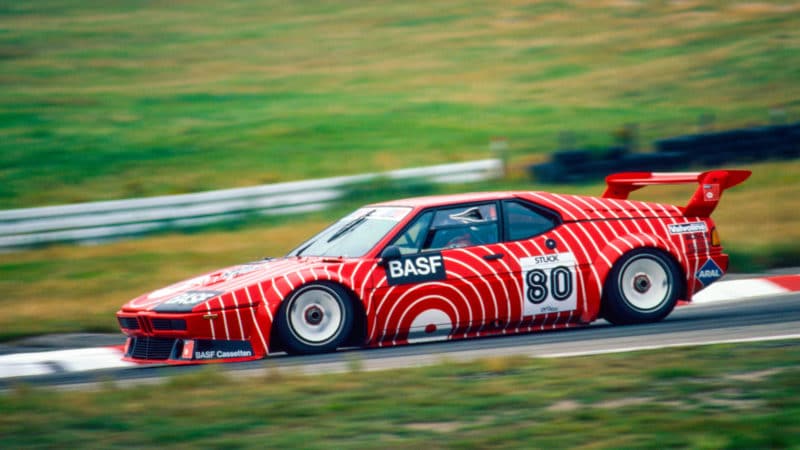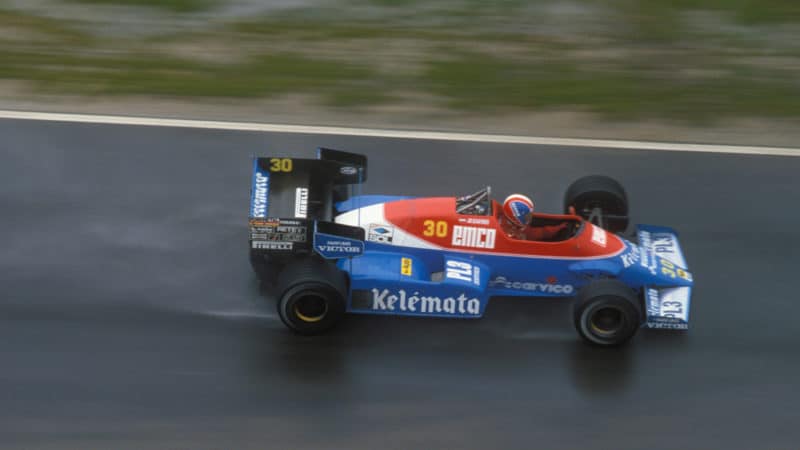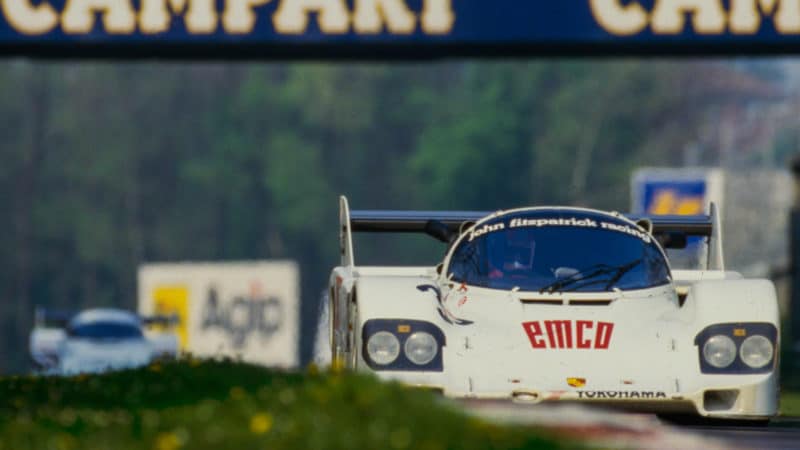Jo Gartner: Running on empty
Jo Gartner scrimped and saved his way to F1 and should have had a top-line sportscar career if he hadn't crashed to his death at Le Mans. Adam Cooper looks back

Jo Gartner raced in F1 for Osella in 1984
DPPI
On January 24 last year a group of people gathered near Vienna to celebrate what would have been the 50th birthday of Jo Gartner. Often overlooked today, the Austrian was sometimes regarded as something of an outsider, perhaps because the only way he could make it in motorsport was by running his own show.
But those who had the chance to get to know him well found a charismatic and engaging personality, and that’s what drew them to the party nearly 18 years after his death in the 1986 Le Mans 24 Hours.
Among the pilgrims was Stuart Dent, who was one of Gartner’s closest friends. “We knew it wasn’t going to happen, but we all felt like we were just waiting for Jo to walk through the door,” says Dent. “He was a lovely guy, very outgoing, very witty. He had a sparkle in his eye and a toothy smile. Like anyone else he could be moody — he could go into serious mode, normally when he was concentrating on the car. He had a little black book with every set-up change for every F2 circuit and he was devastated when it was nicked from outside a hotel in London.”
The son of a garage owner in Vienna, Jo grew up with an enthusiasm for engineering, and that’s what drew him into motor racing. He went to a technical high school and did an apprenticeship with Kaimann Formula Super Vee constructor Kurt Bergmann. Skilled with the drawing board, the youngster soon got involved in the design side. But in the time-honoured tradition he felt he could drive at least as well as those whose chassis he was fettling.
“We said, ‘Do we have steaks for dinner or save some more money for engines and tyres?”
After some hillclimbs with a Super Vee, Gartner embarked on a racing career in 1977. He was already 23 but progress was fast, and in his second season he was a front-runner in the European FSV Championship. In 1979 he moved up to Formula Three with a Martini, racing when he could afford to — there was no family money.
Despite a relatively modest CV he took the step up to Formula Two in 1980. He acquired an outdated March 782, loaded it into the back of his converted coach and headed off to Hockenheim. Technology had moved on, but Gartner qualified a shock seventh on his debut. A puncture spoiled his race, and the death of countryman Markus Höttinger overrode any joy he felt at having reached this level. He missed the next few races before returning to finish a fine seventh at Silverstone. Despite support from BMW engine tuner Max Heidegger, he could only afford to contest three more events.

Gartner first met Hans-Joachim Stuck when he joined the Procar grid
Meanwhile, Höttinger’s death had left an opening in Helmut Marko’s BMW M1 Procar team, and as the most promising Austrian available Jo got the job. Suddenly he was sharing the track on grand prix weekends with Nelson Piquet, Alan Jones and Hans Stuck. That helped to raise his profile and led to him meeting the woman with whom he would share the rest of his life: 18-year-old Doris Slezak had been a child actress and was about to become a medical student; in the interim she was earning some pocket money working for a local newspaper.
“I was a lifestyle journalist, let’s say, and he was a famous VIP in Vienna,” she recalls. “We met in a coffee shop. It was quite a long interview! It was to find out things like what his hobbies were and who his girlfriend was. And there wasn’t one…”
There soon would be: “We realised that we were made for each other. First of all I found him a very good-looking guy! I was always impressed by his sensitive way with people. Apart from racing he was very interested in literature and he loved to discuss Hermann Hesse.
“In F2 I soon found out that I had a lot of work to do, taking the lap times, cooking for the mechanics, cleaning the car. Jo was team manager, engineer and driver, all in one. We always had to say, ‘Do we have steaks for dinner or do we save some more money for engines and tyres?”
He bought an ex-works Toleman TG280 for 1981 but couldn’t afford to run until the fourth race at the Nürburgring, where he qualified fifth. His talent was underlined by third on the grid at Spa, but the only point in his five outings came at Enna.
It seemed that Jo’s prayers were answered when he was offered a free drive by Arturo Merzario, but the chaotic Italian outfit struggled to match the standards of his privateer effort and ’82 was a disaster.
Jo resolved to do his own thing again in 1983, so he bought a Spirit 201 and converted it from Honda to BMW power. Fourth with the privateer ‘bitza’ at Hockenheim boded well. But his day of days came at Pau, where he stayed out on worn-out wet-weather tyres on a drying track. He fought his way into the lead only to be outfumbled by a slickshod Alain Ferté in the closing laps. When the Maurer man was disqualified for an underweight car, Gartner was awarded victory. He finished sixth in the championship and, more importantly, he had a right to a superlicence.

Osella was the route to a difficult F1 promotion
Grand Prix Photo
The only F1 opening for 1984 was at Osella and, having found some backing, Jo made his debut at Imola with the team’s ageing V12-powered car. Matters weren’t helped by a controversial bump with a furious Nigel Mansell in qualifying, but he hauled the thing onto the grid, depriving turbo-powered team-mate Piercarlo Ghinzani of a start. Engine failure put him out of the race.
Gartner missed the next five races before returning at Brands Hatch. This time he was armed with a turbo, but became the innocent victim of a first-lap skirmish. He had to make do with whatever equipment was left over and reliability was poor. “Osella was a little bit like Merzario,” says Doris. “Everything was a grande casino! But he had made it to where he wanted to reach: F1. He tried to make the best out of it, but it was very hard with this car.”
Jo was excited about his home race at the Osterreichring, where another local driver was due to make his F1 debut with ATS. Although the pair had never met on the track, Gerhard Berger had vied with Gartner for media attention. The F3 man was better connected, not least with BMW. “There was a big competition,” Doris confirms. “Gerhard had a very big lobby. He was from the Tyrol, a skiing area, and many racing people would go there, like Bernie Ecclestone and Niki Lauda, and they knew him. He was also from a rich family. Jo always asked, ‘Why do some people have it so easy?”
Gartner qualified two places behind Berger on the grid, and at the start the two Austrians contrived to collide. Both emerged unscathed, but an early engine failure ruined Jo’s day. At Monza things fell into place. In a race of high attrition he plugged away to finish an impressive fifth, ahead of Berger. “It was the greatest day of his career,” says Doris. “He was so very happy. When he came to Vienna all the TV stations asked for an interview.”
An anomaly in the rules ensured that extra entries scored no points, so Jo would be denied his place in the points-scoring history books.
He was looking for better things in 1985 and worked hard to find a budget to take to Arrows-BMW. Things seemed to be falling into place when, a month before the first race, he got a shock: BMW had played its trump card. “Suddenly he heard on the radio that Gerhard Berger had the Arrows drive,” says Doris. “It was one of the most frustrating days of his life. He was not seen for 12 hours. I wasn’t there, but people said he was in a bar…”
Disillusioned with F1, Gartner had little choice but to tread water in sportscars. He had a few impressive outings with John Fitzpatrick’s Porsche 956s, partnering David Hobbs and Guy Edwards to fourth on his Le Mans debut.
A move to one of the German-speaking teams was logical, and Kremer beat Joest to his signature for 1986. He also found employment with Bob Akin in IMSA and began the year with a memorable win in the Sebring 12 Hours, sharing with the team boss and Stuck. Jo crossed the line on three wheels…

When F1 plans fell through in ’58, Gartner turned to sportscars – here at Monza in a John Fitzpatrick Porsche 956
DPPI
With Kremer he won an Interserie race at Thruxton and took third alongside Tiff Needell in the Silverstone 1000Km. Porsche recognised the potential and, encouraged by Stuck, approached him about a works seat for 1987. Although in his heart Jo wanted to get back to F1, his head told him that sportscars would allow him to make it as a professional.
At Le Mans Gartner was to be partnered by Sarel van der Merwe and Kunimitsu Takahashi. Doris takes up the story: “His younger brother Fritz got married the weekend before. Jo was sad not to be there, but he had a contract and had to race at Lime Rock. He flew to Orly airport, we met and went down to Le Mans in a hire car. He was very tired and he wanted to sleep. But then it was business as usual.
“The car was quite new and he couldn’t do the first test because of Lime Rock, so Harald Grohs had done it. He was a little bit fed up because it was not set up the way he preferred, so he had lots of work. The qualifying position wasn’t very good.”
Nevertheless, he tried to present a happy face: “He had learned in the years before that it was very important to be a ‘sunny boy’. He had analysed the reasons for the success of Berger and one big point was his attitude, always laughing. And he tried to be like that a little bit so he was funny, making small talk.”
From 15th the Kenwood-backed Porsche 962 made steady progress. It rose to seventh in the seventh hour before losing a couple of spots in the early hours of the morning. “Jo always said, ‘When you are with me your place is in the pits and I feel when you are there.’ So as usual I was in the pits. Before he went to the car for the last time he said, ‘When I’m back I want to have a strawberry yoghurt’. I watched the lap times and then suddenly the car did not come round. So I sat there with my strawberry yoghurt and waited and waited. Then a pit marshal asked Mr Kremer to come to the race director and I followed him. And they said there was an accident and Jo was dead.”
Shortly after 3am the 962 had veered sharply to the left as it entered the Mulsanne Straight, well before it was up to maximum speed. It cleared the barrier and struck a telegraph pole before tumbling back onto the track and sliding to a halt straddling the barrier on the right, fiercely ablaze. The marshals took an age to deal with the fire.
Doris went to the hospital, arriving before Jo’s body was brought in. To her astonishment he was still wearing helmet, overalls and gloves and to this day she voices doubts about the attention he received at the scene. Mercifully he was probably killed in the initial impact. He was just 32 years old.
The cause of the accident was never officially determined. There were suggestions that Jo had swerved to avoid a rabbit or even a marshal crossing the track. “Porsche said that, but I knew that Jo would never brake for a rabbit!” says Doris. “In one of the pitstops they did something on the rear suspension. He asked me to see what they were doing and he said he felt something might be broken because the car felt undriveable. I think that some hours afterwards the other side broke.”
Doris later married touring car racer Heribert Werginz and in 1990 she qualified as a doctor, having finally found time to complete her studies. Jo has remained a big part of her life and it was she who organised the 50th-birthday bash.
“I’ve always thought that he is still a young and good-looking guy and all the others are in their fifties!” she smiles. “It is the only advantage of the accident, that he is forever young.”
